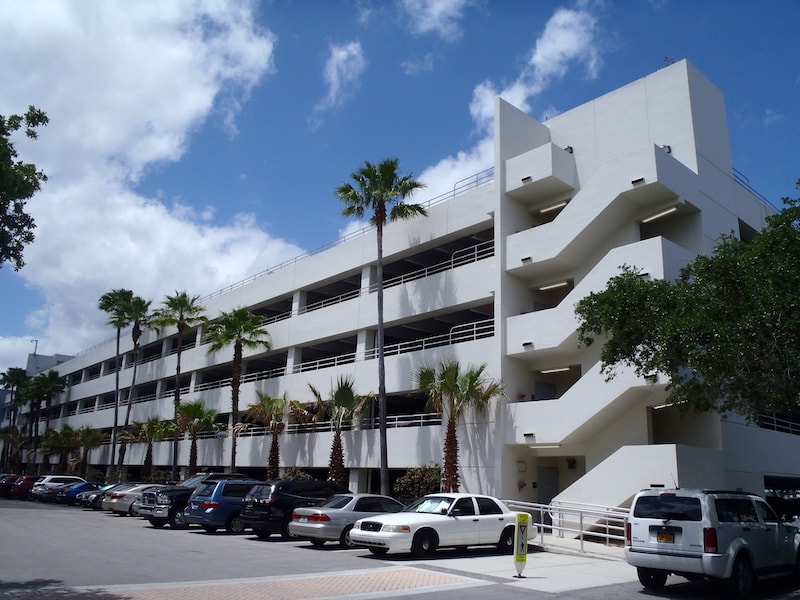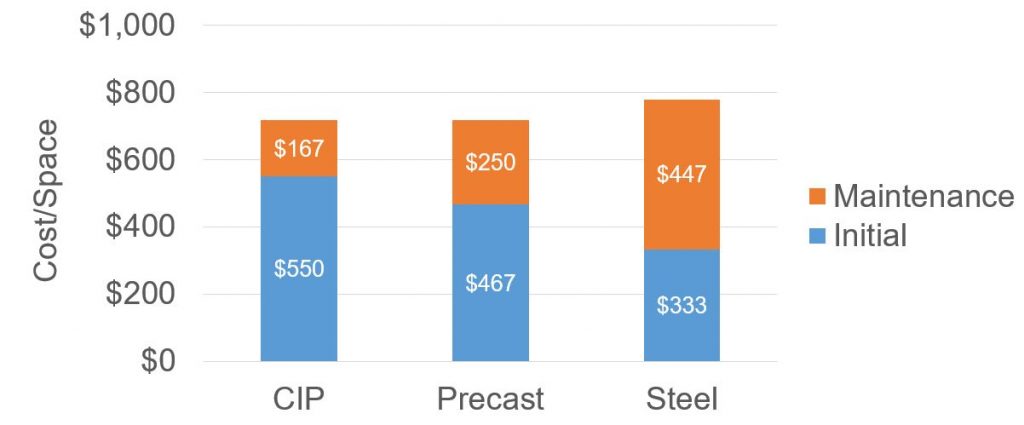
Whether your parking structure is a multi-level garage or a few below-grade levels under a high-rise building, proactive condition assessment and diligent maintenance are imperative.
If problems are ignored, the harsh environment in garages, including corrosive deicing chemicals, freeze-thaw cycling, and the stress of thousands of vehicles traversing the deck, will quickly accelerate deterioration into hazardous conditions.

Here’s what you need to know about the integrity of your parking structure:
There are three common construction types for parking structures: Cast-In-Place Concrete, Precast Concrete, and Structural Steel. As seen in the graph, Cast-In-Place represents a higher initial cost with lower maintenance costs, while structural steel represents a lower initial cost with higher maintenance costs. Precast concrete falls in between in both maintenance and initial costs.
Cast-In-Place Parking Structures
Parking structures made from Cast-in-Place are formed and poured in place, allowing for flexible geometry of the structure. Their monolithic design leads to fewer joints where deficiencies can arise. This leads to reduced maintenance costs, longer life expectancy, and overall higher durability.
Precast Parking Structures
Precast parking structures require a lower initial investment than Cast-in-Place concrete structures, and are fabricated in a controlled plant that is not dependent on weather. This leads to a faster and more affordable construction schedule.
However, precast parking structures, while presenting a lower initial cost as compared to Cast-in-Place concrete parking structures, also present some disadvantages. The potential lack of a local plant may present construction delays, and the specific nature of the prefabricated concrete members lead to less flexibility in the geometric design of the structure. Additionally, more joints in the construction may leave the structure open to deficiencies and thermal expansion/contraction.
Steel Parking Structures
Steel Parking Structures present a far lower initial cost and accelerated construction schedule as opposed to concrete structures, but the nature of the steel members can lead to corrosion/rusting issues, and therefore higher maintenance costs. Additionally, this type of deck is not suited for fire protection.
Many see the outwardly rugged nature of a Parking Structure and assume that they are indestructible and require little maintenance. Unfortunately, this is simply not true. Many parking structures lack a true building envelope, and instead leave their structural components exposed to the elements. This leads to deterioration before construction has even completed. This deterioration is often ignored until a critical failure has occurred, resulting in much higher maintenance costs and risk of property damage, injury, or even death.

Don’t Defer Routine Parking Structure Maintenance!
Reactive maintenance represents the cost of doing nothing. If routine maintenance is deferred for too long, the costs will add up, leading to a situation in which maintenance costs outprice those of demolition and construction of a new structure. This leads to a smaller amount of parking spots for your facility, and potentially unhappy visitors.
If you own or operate a parking structure, a good maintenance program is required to prevent costs from adding up exponentially down the line. A plan should be developed to account for the structural, operational, and aesthetic components of the parking structure’s design. Maintenance should be performed proactively rather than reactionarily!
The IEI Structural Engineering Advantage
Our engineers at IEI specialize in parking structure restoration. We’ll walk your facility and let you know of any conditions that require immediate attention and what maintenance activities you can perform now to extend the life of your facility. Give us a call today!
